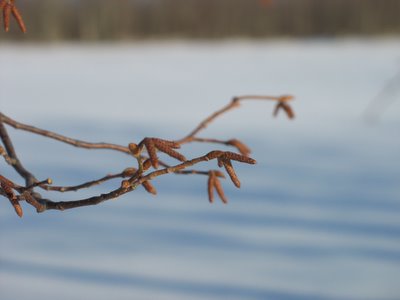signs of spring
 Above, the catkins of what I think is Eastern Hophornbeam, Ostrya virginiana (do correct me if I'm wrong!). It's a small, round-topped tree with reddish-brown bark broken into thick, narrow scales that are loose at the ends, giving the trunk a shaggy appearance. It seems to be growing in areas where I believe the soil to be quite dry.
Above, the catkins of what I think is Eastern Hophornbeam, Ostrya virginiana (do correct me if I'm wrong!). It's a small, round-topped tree with reddish-brown bark broken into thick, narrow scales that are loose at the ends, giving the trunk a shaggy appearance. It seems to be growing in areas where I believe the soil to be quite dry. 
In a bit of contrast to yesterday, today's walk was more than bearable, it was fun! Yesterday, the wind was so bitter, that dressing for it was difficult. I ended up having a freezing face and very cold feet, but the rest of me was totally overheated. It's always a puzzle, how to keep warm without some part of me overheating or freezing on my walks in the winter time.
The snow is fairly light and dry, in a layer about 3-4" deep on top of the crusty stuff we had earlier in the year. Where the wind had piled the snow into drifts however, it can get to be pretty heavy going. Sometimes the crust is solid enough to hold my weight, sometimes it's not, and I step through, up to my knees in snow in some places. Where the ice was not trustworthy before, I now walk on it with impunity. In many places, where the ice was polished smooth by the thaws and traffic of our vehicles and the logger's machinery, the covering of snow hides a glassy surface with no real traction. The variety of conditions would make for a plethora of words for snow, if the English language had that vocabulary.
Today, there was only the barest breeze. The sun was shining and although it was cold enough, I could tolerate having my gloves off to take photographs. Everywhere, on all the trees and shrubs, the buds formed last fall are showing colour. 
Here, the buds of the American Beech, Fagus grandifolia. 
Many immature beech saplings hold on to their leaves late into the winter. At this time of the year, when a leaf is blowing around on top of the snow, it's most likely to be the leaf of a beech.

The bark which is smooth and grey on even large trunks often attracts vandals who like to carve their initials into it.
And of course, the algae, mosses and lichens continue to thrive. They don't seem to mind the cold and snow at all. I believe those red dots in the first photo are fruiting bodies. I really want to find a resource that will help me identify these things. Anybody have any suggestions?



Above, the twigs of Red-osier Dogwood, Cornus sericea (C. stolonifera), here make a brilliant show against the snow and the cedar-rail fence. A fairly small shrub, it is quite widespread in our area. It can usually be found along watercourses and in similar moist locations. Here, it's in a depression that gets quite wet with the run off from the fields above it, after a thaw or after a lot of rain.
On an old dying maple tree beside our laneway, quite close to the house, the pileated woodpecker is busy, hammering away constantly -- sometimes even he's even at it at ten o'clock at night. He's leaving behind massive holes in the trunk of the tree. I'm hoping with luck to get a picture of him in the next day or two.
How interesting to read Jude describing the end of summer in the southern hemispheres, harvesting fruits that make my mouth water! In our part of the world, we had to turn the radio off yesterday when they announced that Canada's weather forecasters are predicting a late, cool spring...that is not what we want to hear!





2 Comments:
I absolutely love the burgundy-red of Dogwood against the snow. One of the prettiest sights in winter :)
Thanks Randa! It is one of my favorites too. It can almost make me drive off the road if I spot some in a ditch, say, with the light just right...
Post a Comment
<< Home